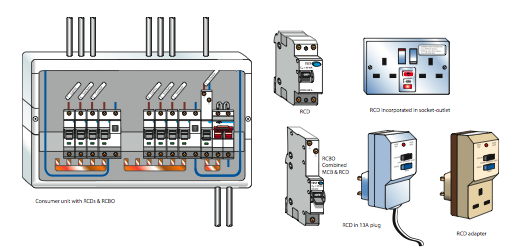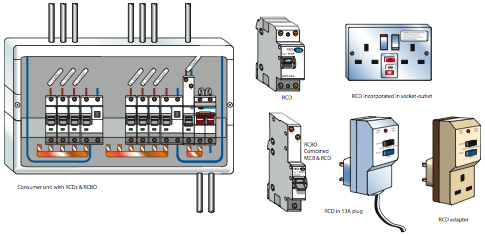In a previous article, I wrote about the requirements of and for RCD protection based on BS 7671AMD 2. The requirements of and for RCD protection remains one of the most regularly asked questions on the helpline from contractors and members of the public. Today, I would like to take the opportunity to outline what the new RCD requirements are within AMD 3.


For contractors that work purely on domestic installations, there will not be that many changes that you will encounter in AMD 3 from AMD 2 relating to RCD protection, and even the amended requirements of Regulation 701.411.3.3 will have very little practical effect on the wiring in a domestic installation. Regulation 701.411.3.3 states “additional protection by the use of one or more RCDs having the characteristics specified in regulation 415.1.1 (30 mA) shall be provided for low voltage circuits:
- Serving the location
- Passing through zones 1 and/or 2 not serving the location.
It is point 2 above that contractors need to be aware of here. Point 2 is stating that RCD protection is required for cables both serving items in the zones (lights/fans etc.) and also for cables passing through the zones. RCD protection isn’t required for cables passingthrough any other part of the room containing the bath or shower (outside the stated zones), as long as those cables don’t feed items of equipment within the room.
Under such circumstances, however, there may still be a requirement for RCD protection where cables, for example, are buried in walls at a depth of less than 50 mm.
For contractors that work on commercial and industrial installations, there are changes that you need to be aware of for RCD protection and more importantly, for the omission of RCD protection.
In AMD 2, Regulation 522.6.102 implied that if an installation was under the supervision of a skilled or instructed person, RCD protection could be omitted for socket-outlets with a rated current not exceeding 20A, even if the cable had be installed in a fashion that if it was in a domestic installation would have to have been RCD protected. In AMD 3, the above statement has been revised and Regulation 411.3.3 now states:
In a.c. systems, additional protection by means of an RCD in accordance with regulation 415.1
(30 mA) shall be provided for:
i. Socket-outlets with a rated current not exceeding 20 A and
ii. Mobile equipment with a current rating not exceeding 32 A for use outside
An exception to (i) above is permitted:
i. Where, other than for an installation in a dwelling, a documented risk assessment determines that the RCD protection is not necessary or
ii. For a specific labelled or otherwise suitably identified socket-outlet provided for a specific item of equipment
The requirements of a documented risk assessment will be discussed in a subsequent article. Additional information regarding RCD requirements are also listed within Regulation 522.6.202, Regulation 522.6.203 & Regulation 522.6.204.
If you wish to omit RCD protection under regulation 522.6.202 (cables installed in a wall or partition at a depth of less than 50 mm), then one of the options detailed in Regulation 522.6.204 must be met. Similarly, if you wish to omit RCD protection under Regulation 522.6.203 (cables concealed in a wall or partition having metallic parts), you have to comply with one of the options detailed in Regulation 522.6.204. You would still need to provide a detailed documented risk assessment for installations that are non-dwellings (Regulation 411.3.3), if you choose to omit RCD protection however.
When you read Regulations 411.3.3, 522.6.201, 522.6.202, 522.6.203 & 522.6.204 within AMD 3, there is no mention of, or reference to, “a competent person” as there was in AMD 2. Within AMD 3, the “competent person” reference has been removed and a new “Electrically skilled person” reference is made. However, in Regulations 411.3.3, 522.6.201, 522.6.202, 522.6.203 & 522.6.204 there is no reference to this new “electrically skilled person” for the possibility of omitting RCD protection.
That now falls fairly and squarely under the requirement of filling out a detailed documented risk assessment which is then attached to the Electrical Installation Certificate.
Installing generator sets
For contractors that install generator sets in parallel with normal supplies (Regulation 551.7.1) there is also a slight alteration from AMD 2 to AMD 3. In AMD 3, both criteria of Regulation 551.7.1 need to be met and they are:
- Protection against thermal effects in accordance with Chapter 42 and protection against overcurrent in accordance with Chapter 43 shall remain in all situations
- Where an RCD is providing additional protection in accordance with Regulation 415.1 for a circuit connecting the generator set to the installation, the RCD shall disconnect all live conductors, including the neutral.
Conclusion
In general, if you are dealing with domestic installations only, there are minimal changes to the requirements of and for RCDs to be aware of. If you are dealing with commercial or industrial installations, there are changes you need to be aware of but you can omit RCD protection as long as a detailed documented risk assessment is completed by you/designer in consultation with the client and attached to the Electrical Installation Certificate.
For other guidance and publications please see the ELECSA website.
For information about the ELECSA schemes, visit www.elecsa.co.uk or call 0333 321 8220
